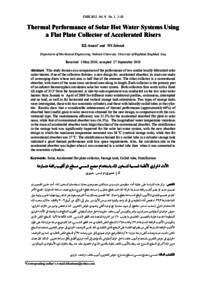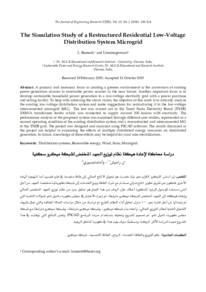Document
Thermal performance of solar hot water systems using a flat plate collector of accelerated risers.
Contributors
Jabouri, N. S., Author
Publisher
Sultan Qaboos University
Gregorian
2012
Language
English
English abstract
This study focuses on a comparison of the performance of two similar locally-fabricated solar water heaters. One of the collectors features a new design for accelerated absorber; its risers are made of converging ducts whose exit area is half that of the entrance. The other collector is a conventional absorber, with risers of the same cross sectional area along its length. Each collector is the primary part of an indirect thermosyphon circulation solar hot water system. Both collectors face south with a fixed tilt angle of 33.3° from the horizontal. A side-by-side experiment was conducted on the two solar water heaters from January to April of 2009 for different water withdrawal profiles, continuous, interrupted and no load, as well as for horizontal and vertical storage tank orientations. Two types of storage tanks were investigated, those with two concentric cylinders, and those with helically-coiled tubes in the cylinder. Results show that a considerable enhancement of thermal performance (approximately 60%) of absorbed heat (useful gain) at solar noon was obtained for the new design, in comparison with the conventional type. The instantaneous efficiency was 31.5% for the accelerated absorbed flat plate at solar noon, while that of conventional absorber was (16.5%). The longitudinal water temperature variations in the risers of accelerated absorber were larger than that of the conventional absorber. The stratification in the storage tank was significantly improved for the solar hot water system, with the new absorber design in which the maximum temperature measured was 50 °C (vertical storage tank), while that for conventional absorber was 37 °C. The stratification obtained for a coiled tube in a cylinder storage tank indicated a good thermal performance with less space requirements. Also, the circulation rate in the accelerated absorber was higher when it was connected to a coiled tube than when it was connected to the concentric cylinders .
Member of
ISSN
1726-6742
Resource URL
Citation
Amori, K. E., & Jabouri, N. S. (2012). Thermal performance of solar hot water systems using a flat plate collector of accelerated risers. The Journal of Engineering Research, 9 (1), 1-10.
Arabic abstract
تركز هذه الدراسة على مقارنة أداء منظومتين شمسيتين متماثلتين مصنوعتين محليا تستخدمان لتسخين الماء. أحد هذين المجمعين ذو تصميم جديد إذ يضم أنابيب رافعة متسارعة لحركة الماء ذات مقطع متقارب (مساحة مقطع الخروج تساوي نصف مساحة الدخول). المجمع الآخر كان ذو تصميم تقليدي (الأنبوب الرافع له مساحة مقطع واحدة). كلا المجمعين يعملان بمبدأ الثيرموسیفون غير المباشر ويواجهان الجنوب بزاوية ميل ثابتة مقدارها 33.3. تم فحص أداء المنظومتين في آن واحد ولفترة امتدت من الأول من يناير إلى الأول من أبريل 2009 ولمختلف حالات سحب الماء للاستخدام المنزلي (سحب مستمر، متقطع، أو بدون سحب) مع توجيه أفقي وعمودي لحوض التخزين. كما تم فحص نوعين من الخزان الحراري : حوض خزان ذو أسطوانتين متمرکزتين، وآخر يتكون من أنبوب ملتف حلزونیا داخل خزان أسطواني. أظهرت النتائج تحسنا واضحا في الأداء الحراري للمنظومة الجديدة مقارنة بالتصميم التقليدي بما يقارب 60% من الحرارة الممتصة عند الظهر الشمسي. كانت الكفاءة الآنية للسطح الماص الذي يتكون من الأنابيب الرافعة المتسارعة 31.5% وكانت 16.5% للسطح الماص التقليدي عند الظهر الشمسي، كما كان توزيع درجة حرارة الماء على طول الأنابيب الرافعة المتسارعة أعلى من نظيراتها المقاسة على السطح الماص التقليدي. لقد تحسن التراصف الحراري في حوض التخزين باستخدام السطح الماص الجديد حيث وصلت أعلى درجة حرارة 50 °م (لحالة وضع خزان عمودي) في حين وصلت 37 ° م للسطح الماص التقليدي. كما بين التراصف الحراري في حوض التخزين باستخدام أنبوب ملتف داخل خزان أسطواني بأنه يؤدي إلى أداء حراري أفضل بأقل مساحة تخزين. كذلك كان معدل تدوير الماء أكبر في السطح المتسارع عند ربطه بالأنبوب الملتف مقارنة بالتدوير الذي تم الحصول عليه عند ربطه بالخزان ذي الأسطوانتين المترمركزتين.
Category
Journal articles


